Implementation of evidence-based treatment protocols to manage fever, hyperglycaemia, and swallowing dysfunction in acute stroke (QASC): a cluster randomised controlled trial
VerifiedAdded on 2023/06/11
|10
|2238
|117
AI Summary
This study explores the implementation of evidence-based treatment protocols to manage fever, hyperglycaemia, and swallowing dysfunction in acute stroke (QASC). The study was a cluster randomised controlled trial that used a multidisciplinary intervention to assess the participants. The findings of the study can be applied to different clinical contexts.
Contribute Materials
Your contribution can guide someone’s learning journey. Share your
documents today.
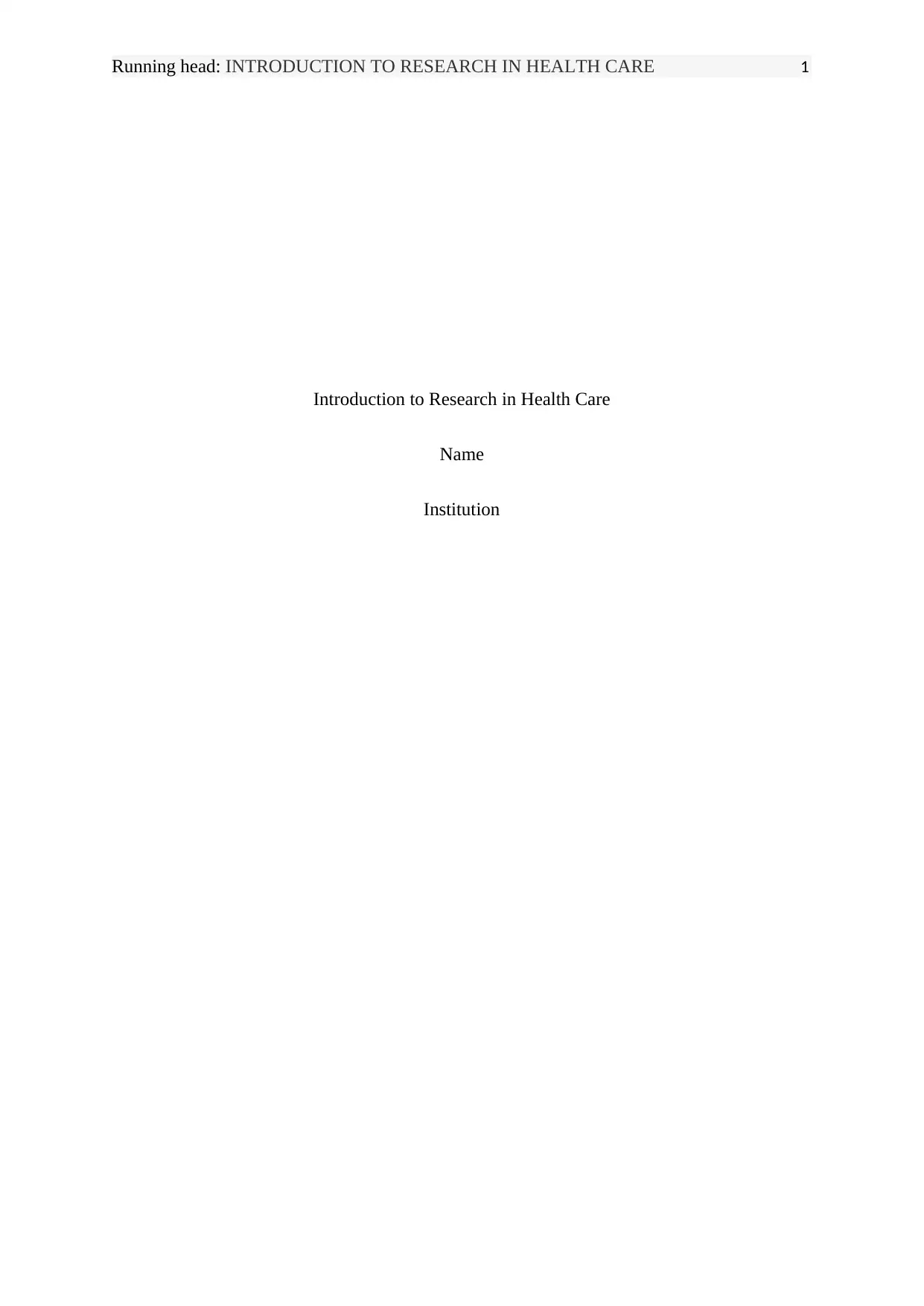
Running head: INTRODUCTION TO RESEARCH IN HEALTH CARE 1
Introduction to Research in Health Care
Name
Institution
Introduction to Research in Health Care
Name
Institution
Secure Best Marks with AI Grader
Need help grading? Try our AI Grader for instant feedback on your assignments.
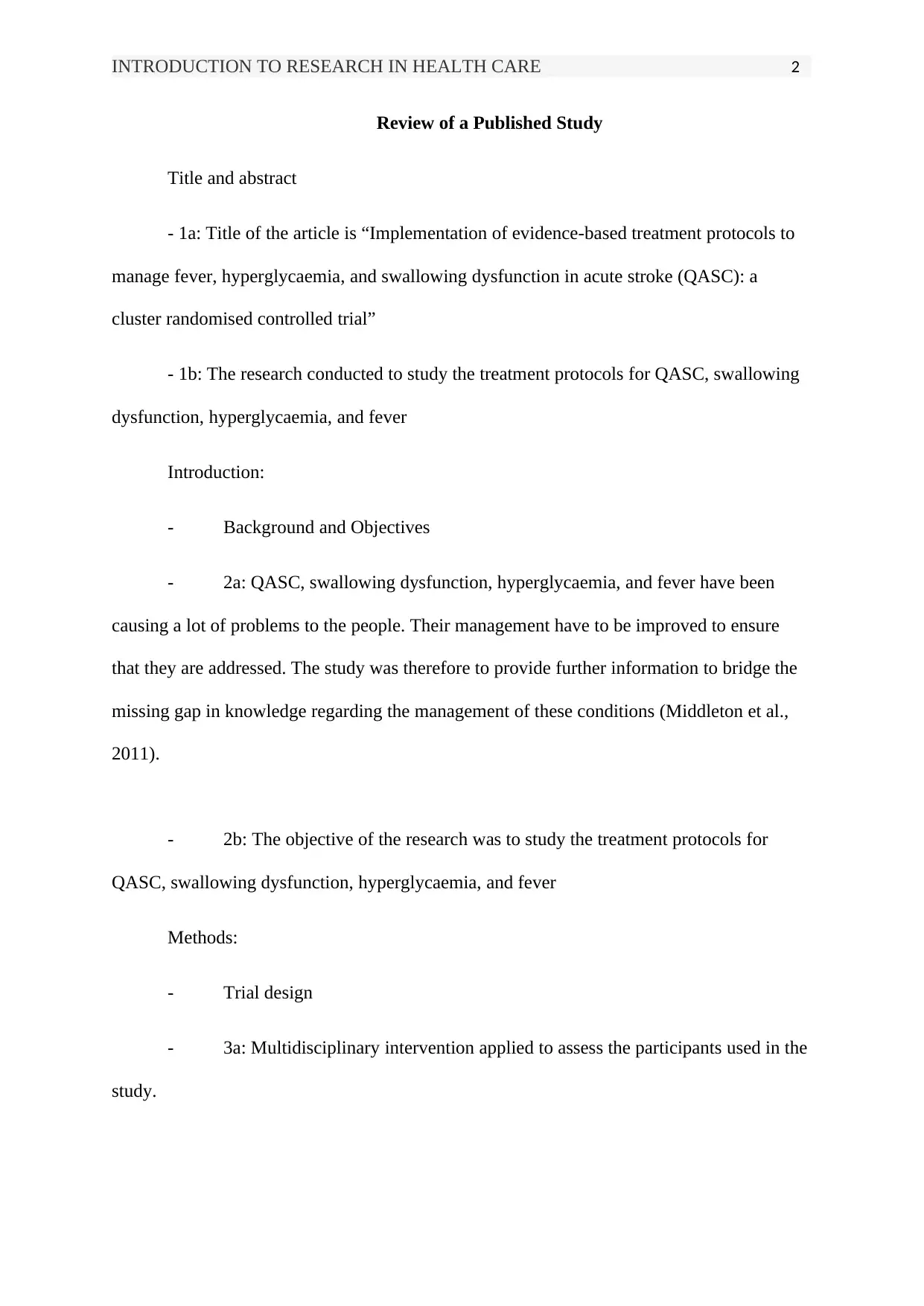
INTRODUCTION TO RESEARCH IN HEALTH CARE 2
Review of a Published Study
Title and abstract
- 1a: Title of the article is “Implementation of evidence-based treatment protocols to
manage fever, hyperglycaemia, and swallowing dysfunction in acute stroke (QASC): a
cluster randomised controlled trial”
- 1b: The research conducted to study the treatment protocols for QASC, swallowing
dysfunction, hyperglycaemia, and fever
Introduction:
- Background and Objectives
- 2a: QASC, swallowing dysfunction, hyperglycaemia, and fever have been
causing a lot of problems to the people. Their management have to be improved to ensure
that they are addressed. The study was therefore to provide further information to bridge the
missing gap in knowledge regarding the management of these conditions (Middleton et al.,
2011).
- 2b: The objective of the research was to study the treatment protocols for
QASC, swallowing dysfunction, hyperglycaemia, and fever
Methods:
- Trial design
- 3a: Multidisciplinary intervention applied to assess the participants used in the
study.
Review of a Published Study
Title and abstract
- 1a: Title of the article is “Implementation of evidence-based treatment protocols to
manage fever, hyperglycaemia, and swallowing dysfunction in acute stroke (QASC): a
cluster randomised controlled trial”
- 1b: The research conducted to study the treatment protocols for QASC, swallowing
dysfunction, hyperglycaemia, and fever
Introduction:
- Background and Objectives
- 2a: QASC, swallowing dysfunction, hyperglycaemia, and fever have been
causing a lot of problems to the people. Their management have to be improved to ensure
that they are addressed. The study was therefore to provide further information to bridge the
missing gap in knowledge regarding the management of these conditions (Middleton et al.,
2011).
- 2b: The objective of the research was to study the treatment protocols for
QASC, swallowing dysfunction, hyperglycaemia, and fever
Methods:
- Trial design
- 3a: Multidisciplinary intervention applied to assess the participants used in the
study.
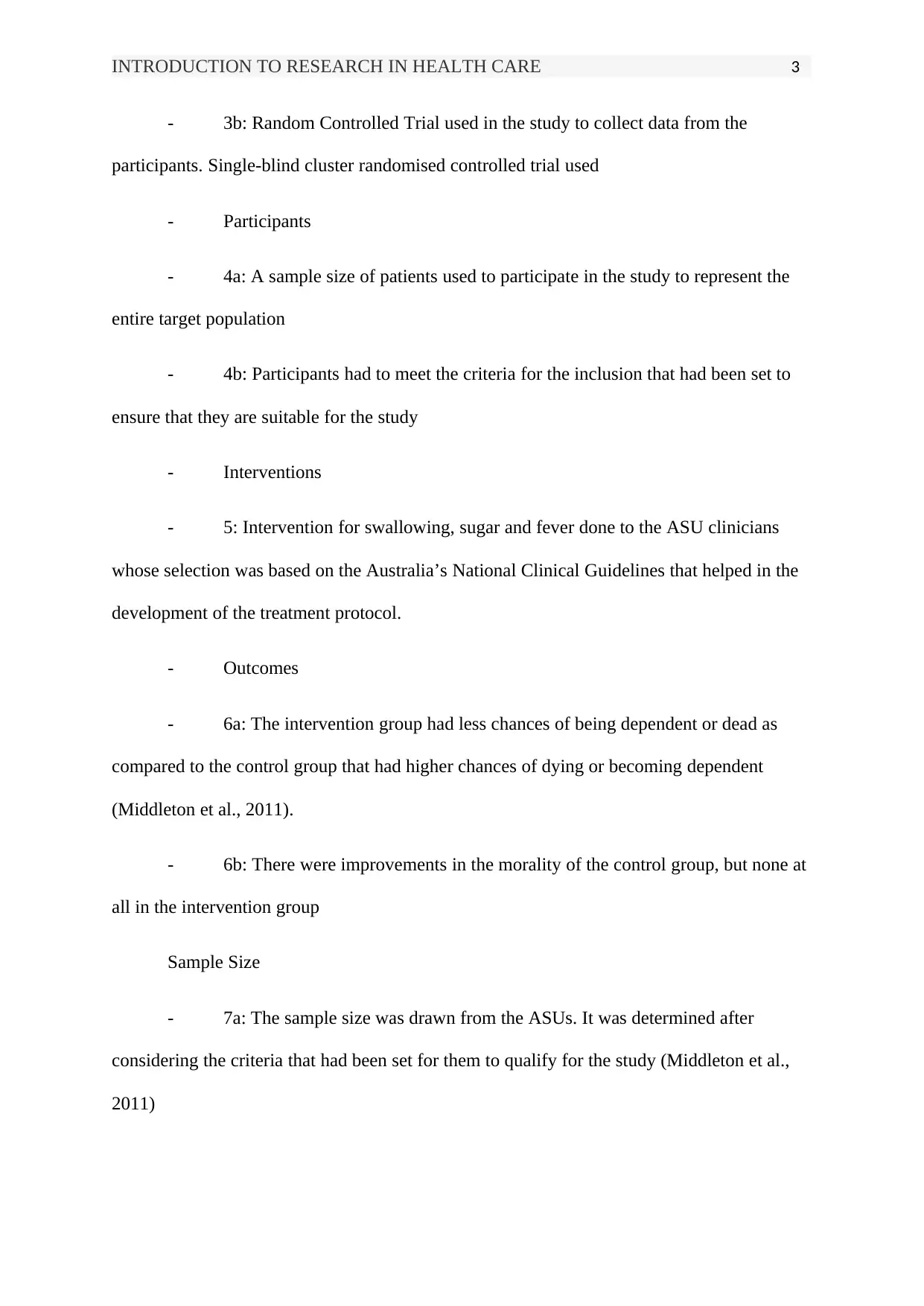
INTRODUCTION TO RESEARCH IN HEALTH CARE 3
- 3b: Random Controlled Trial used in the study to collect data from the
participants. Single-blind cluster randomised controlled trial used
- Participants
- 4a: A sample size of patients used to participate in the study to represent the
entire target population
- 4b: Participants had to meet the criteria for the inclusion that had been set to
ensure that they are suitable for the study
- Interventions
- 5: Intervention for swallowing, sugar and fever done to the ASU clinicians
whose selection was based on the Australia’s National Clinical Guidelines that helped in the
development of the treatment protocol.
- Outcomes
- 6a: The intervention group had less chances of being dependent or dead as
compared to the control group that had higher chances of dying or becoming dependent
(Middleton et al., 2011).
- 6b: There were improvements in the morality of the control group, but none at
all in the intervention group
Sample Size
- 7a: The sample size was drawn from the ASUs. It was determined after
considering the criteria that had been set for them to qualify for the study (Middleton et al.,
2011)
- 3b: Random Controlled Trial used in the study to collect data from the
participants. Single-blind cluster randomised controlled trial used
- Participants
- 4a: A sample size of patients used to participate in the study to represent the
entire target population
- 4b: Participants had to meet the criteria for the inclusion that had been set to
ensure that they are suitable for the study
- Interventions
- 5: Intervention for swallowing, sugar and fever done to the ASU clinicians
whose selection was based on the Australia’s National Clinical Guidelines that helped in the
development of the treatment protocol.
- Outcomes
- 6a: The intervention group had less chances of being dependent or dead as
compared to the control group that had higher chances of dying or becoming dependent
(Middleton et al., 2011).
- 6b: There were improvements in the morality of the control group, but none at
all in the intervention group
Sample Size
- 7a: The sample size was drawn from the ASUs. It was determined after
considering the criteria that had been set for them to qualify for the study (Middleton et al.,
2011)
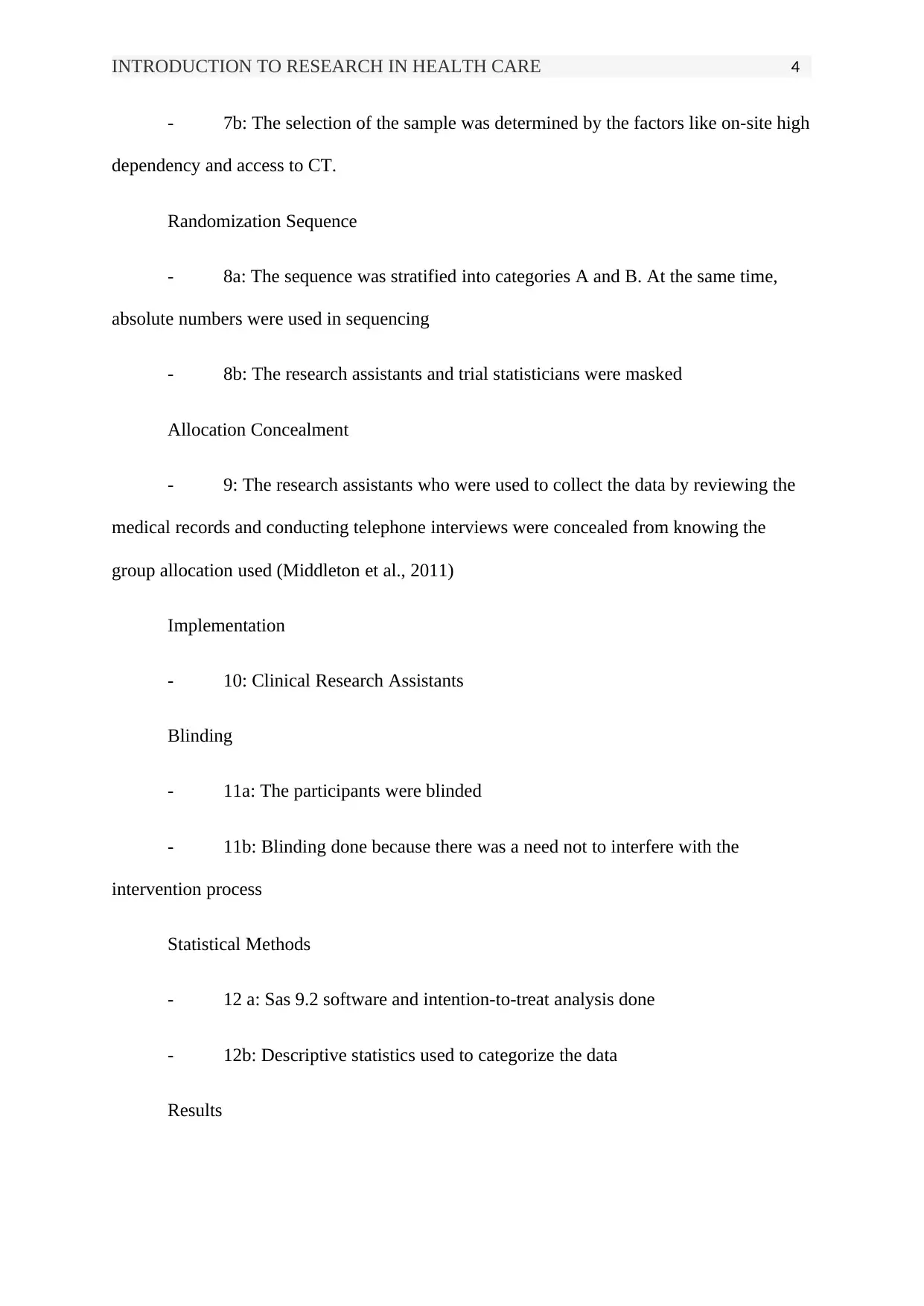
INTRODUCTION TO RESEARCH IN HEALTH CARE 4
- 7b: The selection of the sample was determined by the factors like on-site high
dependency and access to CT.
Randomization Sequence
- 8a: The sequence was stratified into categories A and B. At the same time,
absolute numbers were used in sequencing
- 8b: The research assistants and trial statisticians were masked
Allocation Concealment
- 9: The research assistants who were used to collect the data by reviewing the
medical records and conducting telephone interviews were concealed from knowing the
group allocation used (Middleton et al., 2011)
Implementation
- 10: Clinical Research Assistants
Blinding
- 11a: The participants were blinded
- 11b: Blinding done because there was a need not to interfere with the
intervention process
Statistical Methods
- 12 a: Sas 9.2 software and intention-to-treat analysis done
- 12b: Descriptive statistics used to categorize the data
Results
- 7b: The selection of the sample was determined by the factors like on-site high
dependency and access to CT.
Randomization Sequence
- 8a: The sequence was stratified into categories A and B. At the same time,
absolute numbers were used in sequencing
- 8b: The research assistants and trial statisticians were masked
Allocation Concealment
- 9: The research assistants who were used to collect the data by reviewing the
medical records and conducting telephone interviews were concealed from knowing the
group allocation used (Middleton et al., 2011)
Implementation
- 10: Clinical Research Assistants
Blinding
- 11a: The participants were blinded
- 11b: Blinding done because there was a need not to interfere with the
intervention process
Statistical Methods
- 12 a: Sas 9.2 software and intention-to-treat analysis done
- 12b: Descriptive statistics used to categorize the data
Results
Secure Best Marks with AI Grader
Need help grading? Try our AI Grader for instant feedback on your assignments.
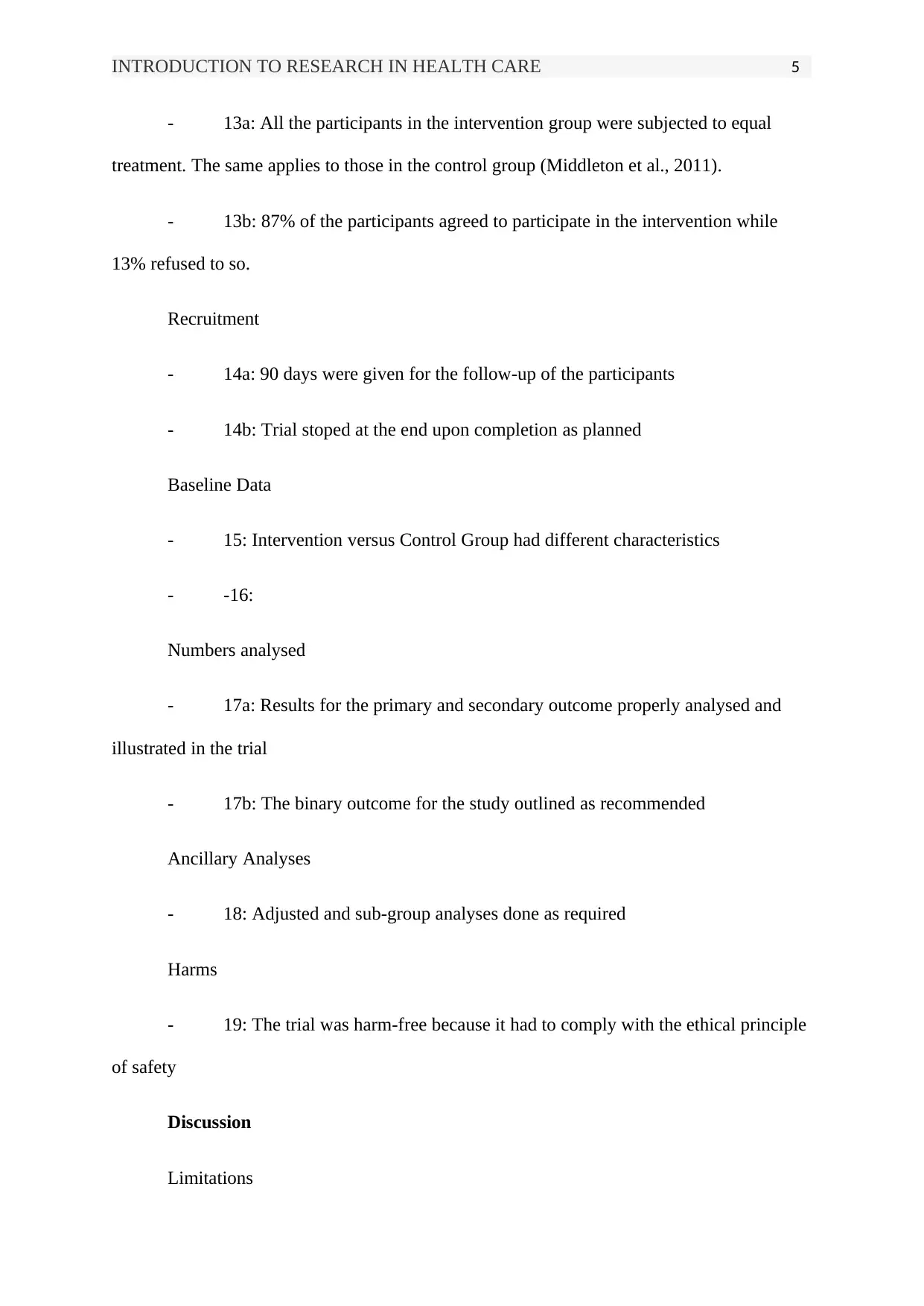
INTRODUCTION TO RESEARCH IN HEALTH CARE 5
- 13a: All the participants in the intervention group were subjected to equal
treatment. The same applies to those in the control group (Middleton et al., 2011).
- 13b: 87% of the participants agreed to participate in the intervention while
13% refused to so.
Recruitment
- 14a: 90 days were given for the follow-up of the participants
- 14b: Trial stoped at the end upon completion as planned
Baseline Data
- 15: Intervention versus Control Group had different characteristics
- -16:
Numbers analysed
- 17a: Results for the primary and secondary outcome properly analysed and
illustrated in the trial
- 17b: The binary outcome for the study outlined as recommended
Ancillary Analyses
- 18: Adjusted and sub-group analyses done as required
Harms
- 19: The trial was harm-free because it had to comply with the ethical principle
of safety
Discussion
Limitations
- 13a: All the participants in the intervention group were subjected to equal
treatment. The same applies to those in the control group (Middleton et al., 2011).
- 13b: 87% of the participants agreed to participate in the intervention while
13% refused to so.
Recruitment
- 14a: 90 days were given for the follow-up of the participants
- 14b: Trial stoped at the end upon completion as planned
Baseline Data
- 15: Intervention versus Control Group had different characteristics
- -16:
Numbers analysed
- 17a: Results for the primary and secondary outcome properly analysed and
illustrated in the trial
- 17b: The binary outcome for the study outlined as recommended
Ancillary Analyses
- 18: Adjusted and sub-group analyses done as required
Harms
- 19: The trial was harm-free because it had to comply with the ethical principle
of safety
Discussion
Limitations
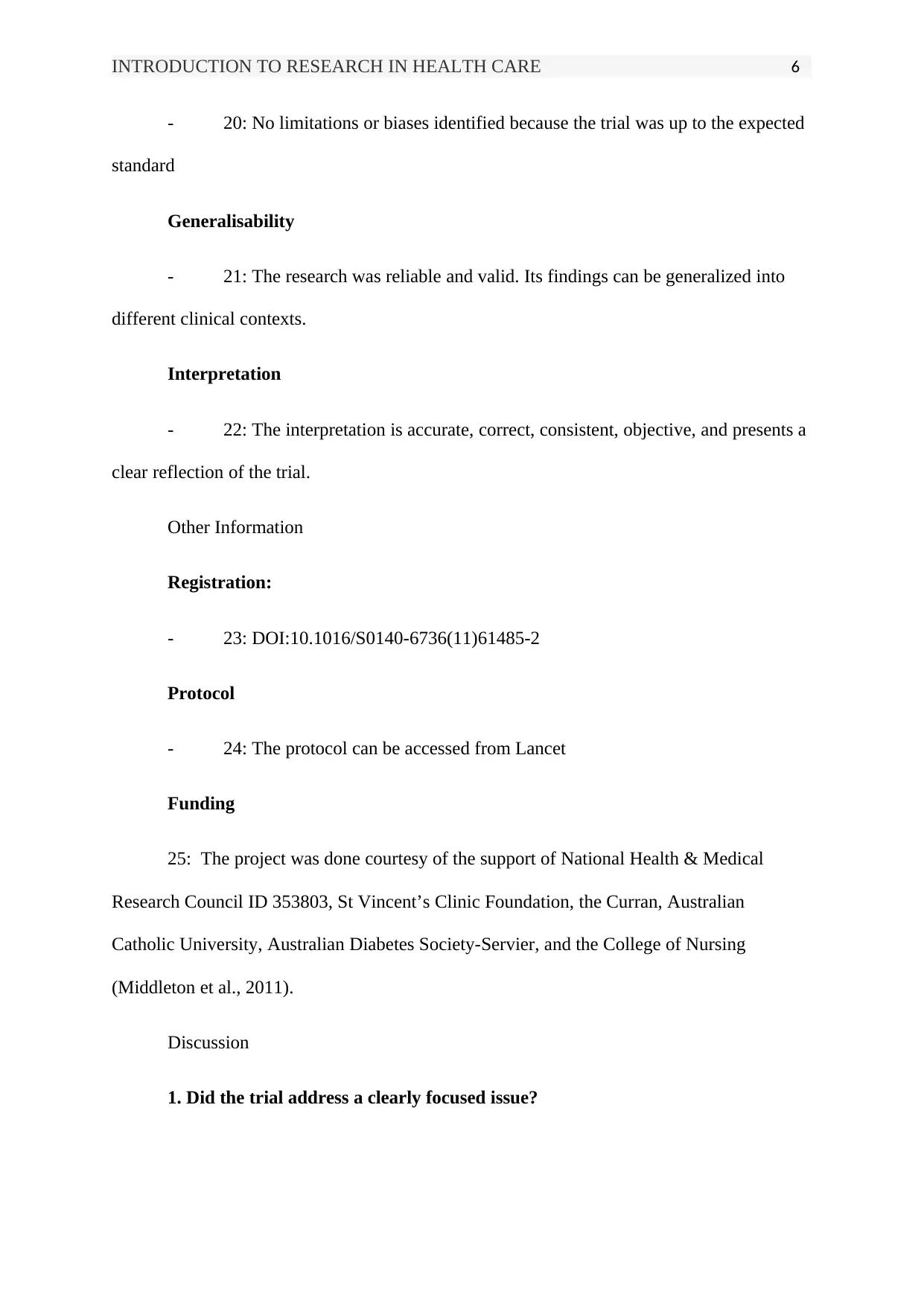
INTRODUCTION TO RESEARCH IN HEALTH CARE 6
- 20: No limitations or biases identified because the trial was up to the expected
standard
Generalisability
- 21: The research was reliable and valid. Its findings can be generalized into
different clinical contexts.
Interpretation
- 22: The interpretation is accurate, correct, consistent, objective, and presents a
clear reflection of the trial.
Other Information
Registration:
- 23: DOI:10.1016/S0140-6736(11)61485-2
Protocol
- 24: The protocol can be accessed from Lancet
Funding
25: The project was done courtesy of the support of National Health & Medical
Research Council ID 353803, St Vincent’s Clinic Foundation, the Curran, Australian
Catholic University, Australian Diabetes Society-Servier, and the College of Nursing
(Middleton et al., 2011).
Discussion
1. Did the trial address a clearly focused issue?
- 20: No limitations or biases identified because the trial was up to the expected
standard
Generalisability
- 21: The research was reliable and valid. Its findings can be generalized into
different clinical contexts.
Interpretation
- 22: The interpretation is accurate, correct, consistent, objective, and presents a
clear reflection of the trial.
Other Information
Registration:
- 23: DOI:10.1016/S0140-6736(11)61485-2
Protocol
- 24: The protocol can be accessed from Lancet
Funding
25: The project was done courtesy of the support of National Health & Medical
Research Council ID 353803, St Vincent’s Clinic Foundation, the Curran, Australian
Catholic University, Australian Diabetes Society-Servier, and the College of Nursing
(Middleton et al., 2011).
Discussion
1. Did the trial address a clearly focused issue?
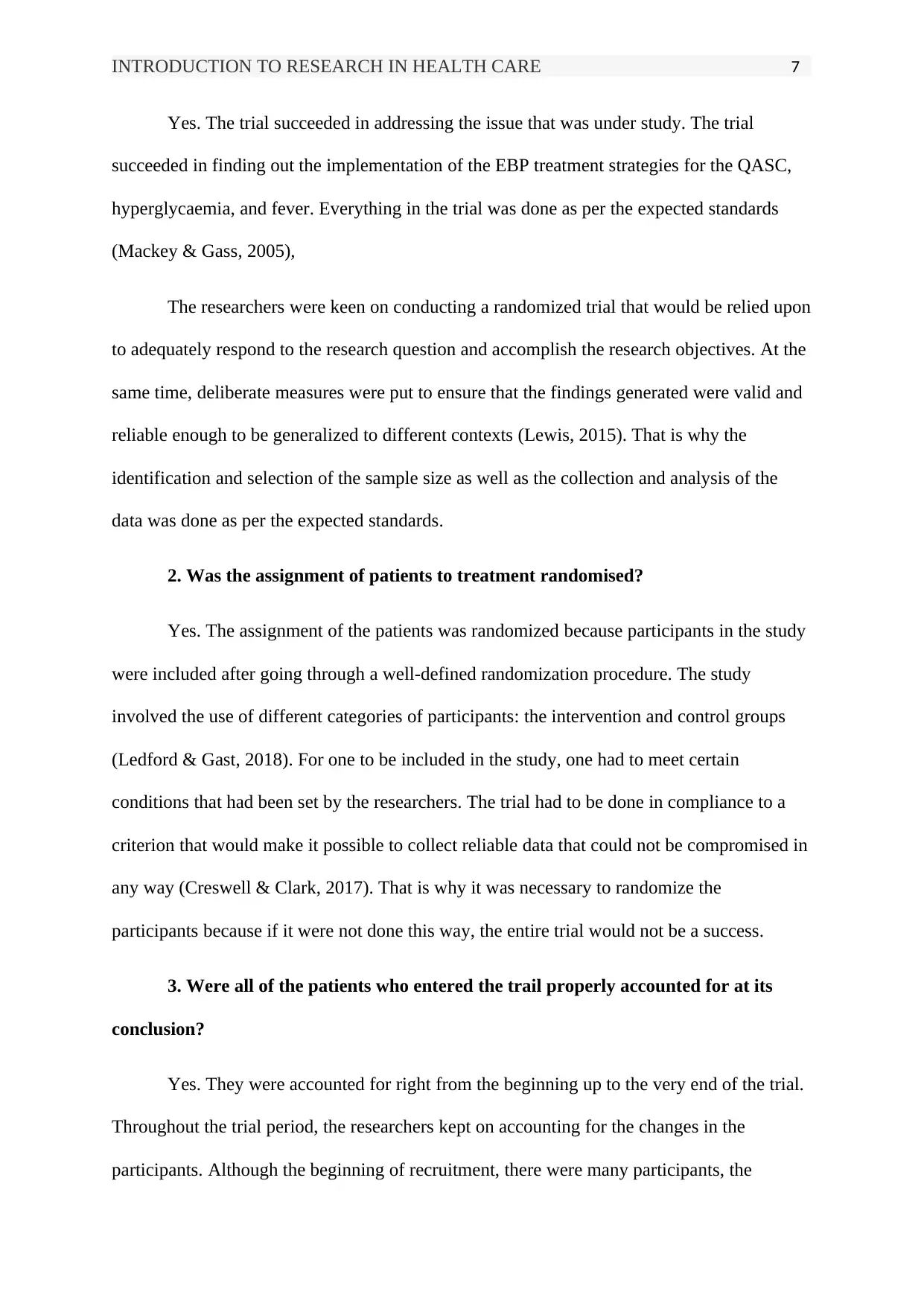
INTRODUCTION TO RESEARCH IN HEALTH CARE 7
Yes. The trial succeeded in addressing the issue that was under study. The trial
succeeded in finding out the implementation of the EBP treatment strategies for the QASC,
hyperglycaemia, and fever. Everything in the trial was done as per the expected standards
(Mackey & Gass, 2005),
The researchers were keen on conducting a randomized trial that would be relied upon
to adequately respond to the research question and accomplish the research objectives. At the
same time, deliberate measures were put to ensure that the findings generated were valid and
reliable enough to be generalized to different contexts (Lewis, 2015). That is why the
identification and selection of the sample size as well as the collection and analysis of the
data was done as per the expected standards.
2. Was the assignment of patients to treatment randomised?
Yes. The assignment of the patients was randomized because participants in the study
were included after going through a well-defined randomization procedure. The study
involved the use of different categories of participants: the intervention and control groups
(Ledford & Gast, 2018). For one to be included in the study, one had to meet certain
conditions that had been set by the researchers. The trial had to be done in compliance to a
criterion that would make it possible to collect reliable data that could not be compromised in
any way (Creswell & Clark, 2017). That is why it was necessary to randomize the
participants because if it were not done this way, the entire trial would not be a success.
3. Were all of the patients who entered the trail properly accounted for at its
conclusion?
Yes. They were accounted for right from the beginning up to the very end of the trial.
Throughout the trial period, the researchers kept on accounting for the changes in the
participants. Although the beginning of recruitment, there were many participants, the
Yes. The trial succeeded in addressing the issue that was under study. The trial
succeeded in finding out the implementation of the EBP treatment strategies for the QASC,
hyperglycaemia, and fever. Everything in the trial was done as per the expected standards
(Mackey & Gass, 2005),
The researchers were keen on conducting a randomized trial that would be relied upon
to adequately respond to the research question and accomplish the research objectives. At the
same time, deliberate measures were put to ensure that the findings generated were valid and
reliable enough to be generalized to different contexts (Lewis, 2015). That is why the
identification and selection of the sample size as well as the collection and analysis of the
data was done as per the expected standards.
2. Was the assignment of patients to treatment randomised?
Yes. The assignment of the patients was randomized because participants in the study
were included after going through a well-defined randomization procedure. The study
involved the use of different categories of participants: the intervention and control groups
(Ledford & Gast, 2018). For one to be included in the study, one had to meet certain
conditions that had been set by the researchers. The trial had to be done in compliance to a
criterion that would make it possible to collect reliable data that could not be compromised in
any way (Creswell & Clark, 2017). That is why it was necessary to randomize the
participants because if it were not done this way, the entire trial would not be a success.
3. Were all of the patients who entered the trail properly accounted for at its
conclusion?
Yes. They were accounted for right from the beginning up to the very end of the trial.
Throughout the trial period, the researchers kept on accounting for the changes in the
participants. Although the beginning of recruitment, there were many participants, the
Paraphrase This Document
Need a fresh take? Get an instant paraphrase of this document with our AI Paraphraser
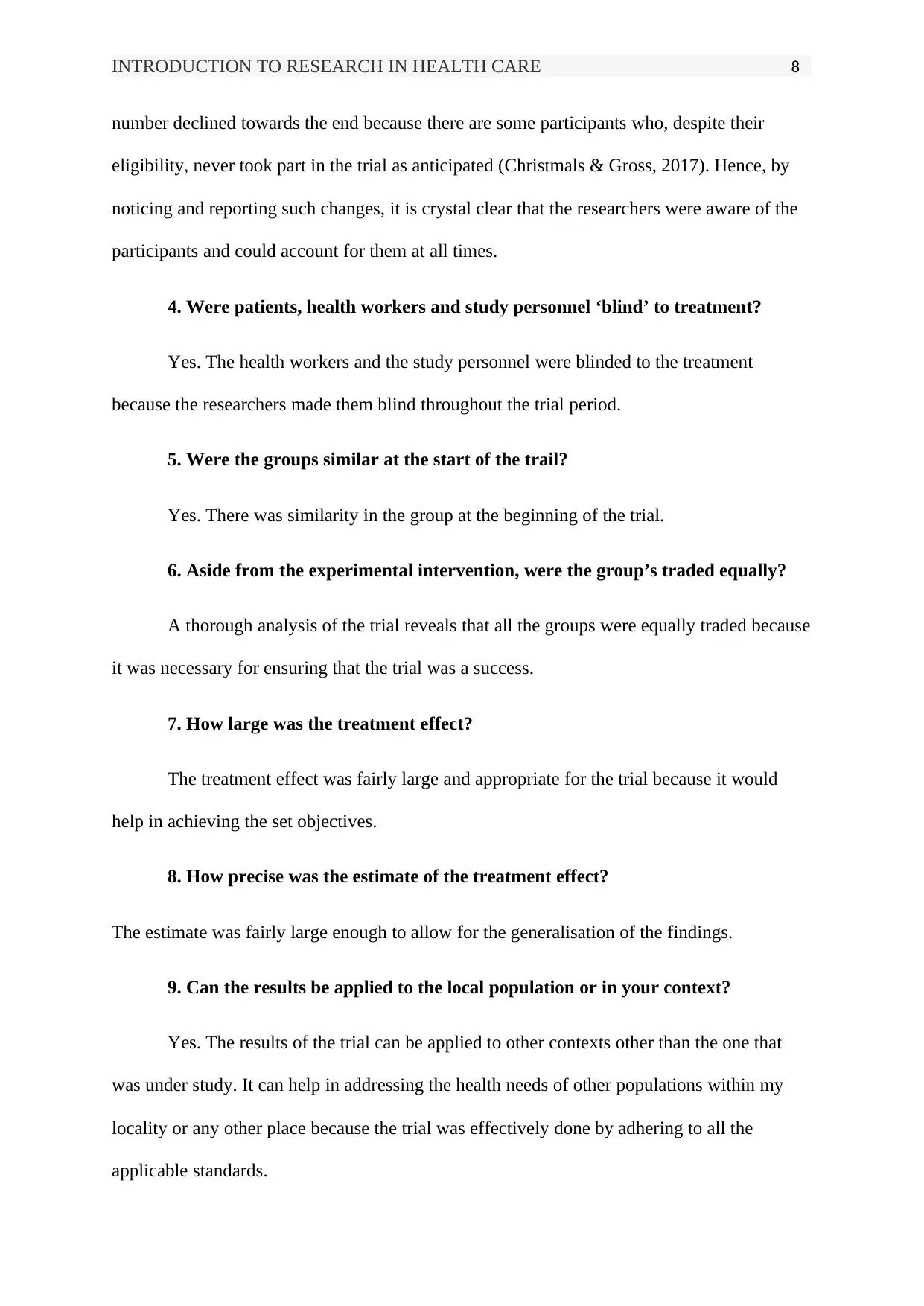
INTRODUCTION TO RESEARCH IN HEALTH CARE 8
number declined towards the end because there are some participants who, despite their
eligibility, never took part in the trial as anticipated (Christmals & Gross, 2017). Hence, by
noticing and reporting such changes, it is crystal clear that the researchers were aware of the
participants and could account for them at all times.
4. Were patients, health workers and study personnel ‘blind’ to treatment?
Yes. The health workers and the study personnel were blinded to the treatment
because the researchers made them blind throughout the trial period.
5. Were the groups similar at the start of the trail?
Yes. There was similarity in the group at the beginning of the trial.
6. Aside from the experimental intervention, were the group’s traded equally?
A thorough analysis of the trial reveals that all the groups were equally traded because
it was necessary for ensuring that the trial was a success.
7. How large was the treatment effect?
The treatment effect was fairly large and appropriate for the trial because it would
help in achieving the set objectives.
8. How precise was the estimate of the treatment effect?
The estimate was fairly large enough to allow for the generalisation of the findings.
9. Can the results be applied to the local population or in your context?
Yes. The results of the trial can be applied to other contexts other than the one that
was under study. It can help in addressing the health needs of other populations within my
locality or any other place because the trial was effectively done by adhering to all the
applicable standards.
number declined towards the end because there are some participants who, despite their
eligibility, never took part in the trial as anticipated (Christmals & Gross, 2017). Hence, by
noticing and reporting such changes, it is crystal clear that the researchers were aware of the
participants and could account for them at all times.
4. Were patients, health workers and study personnel ‘blind’ to treatment?
Yes. The health workers and the study personnel were blinded to the treatment
because the researchers made them blind throughout the trial period.
5. Were the groups similar at the start of the trail?
Yes. There was similarity in the group at the beginning of the trial.
6. Aside from the experimental intervention, were the group’s traded equally?
A thorough analysis of the trial reveals that all the groups were equally traded because
it was necessary for ensuring that the trial was a success.
7. How large was the treatment effect?
The treatment effect was fairly large and appropriate for the trial because it would
help in achieving the set objectives.
8. How precise was the estimate of the treatment effect?
The estimate was fairly large enough to allow for the generalisation of the findings.
9. Can the results be applied to the local population or in your context?
Yes. The results of the trial can be applied to other contexts other than the one that
was under study. It can help in addressing the health needs of other populations within my
locality or any other place because the trial was effectively done by adhering to all the
applicable standards.
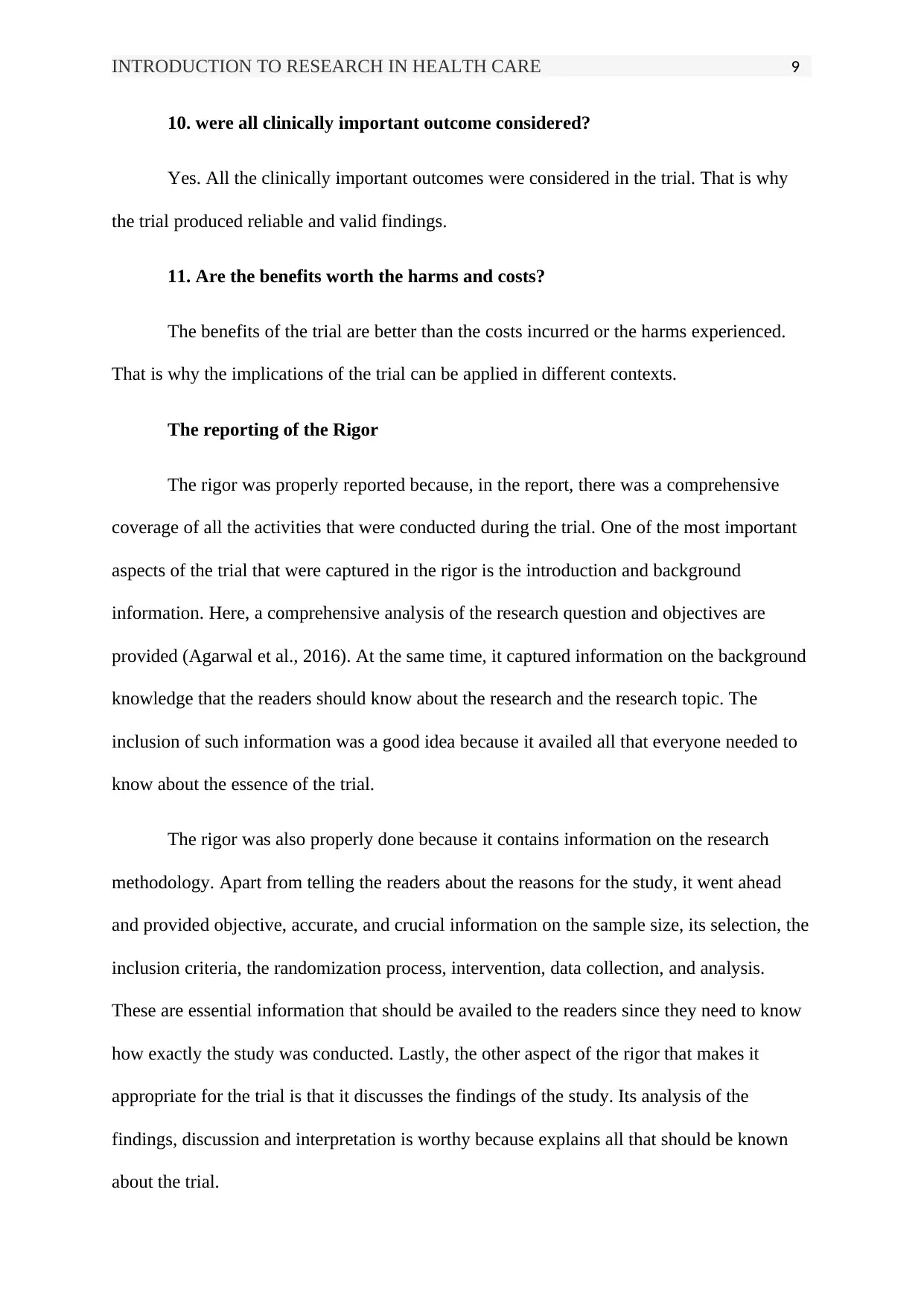
INTRODUCTION TO RESEARCH IN HEALTH CARE 9
10. were all clinically important outcome considered?
Yes. All the clinically important outcomes were considered in the trial. That is why
the trial produced reliable and valid findings.
11. Are the benefits worth the harms and costs?
The benefits of the trial are better than the costs incurred or the harms experienced.
That is why the implications of the trial can be applied in different contexts.
The reporting of the Rigor
The rigor was properly reported because, in the report, there was a comprehensive
coverage of all the activities that were conducted during the trial. One of the most important
aspects of the trial that were captured in the rigor is the introduction and background
information. Here, a comprehensive analysis of the research question and objectives are
provided (Agarwal et al., 2016). At the same time, it captured information on the background
knowledge that the readers should know about the research and the research topic. The
inclusion of such information was a good idea because it availed all that everyone needed to
know about the essence of the trial.
The rigor was also properly done because it contains information on the research
methodology. Apart from telling the readers about the reasons for the study, it went ahead
and provided objective, accurate, and crucial information on the sample size, its selection, the
inclusion criteria, the randomization process, intervention, data collection, and analysis.
These are essential information that should be availed to the readers since they need to know
how exactly the study was conducted. Lastly, the other aspect of the rigor that makes it
appropriate for the trial is that it discusses the findings of the study. Its analysis of the
findings, discussion and interpretation is worthy because explains all that should be known
about the trial.
10. were all clinically important outcome considered?
Yes. All the clinically important outcomes were considered in the trial. That is why
the trial produced reliable and valid findings.
11. Are the benefits worth the harms and costs?
The benefits of the trial are better than the costs incurred or the harms experienced.
That is why the implications of the trial can be applied in different contexts.
The reporting of the Rigor
The rigor was properly reported because, in the report, there was a comprehensive
coverage of all the activities that were conducted during the trial. One of the most important
aspects of the trial that were captured in the rigor is the introduction and background
information. Here, a comprehensive analysis of the research question and objectives are
provided (Agarwal et al., 2016). At the same time, it captured information on the background
knowledge that the readers should know about the research and the research topic. The
inclusion of such information was a good idea because it availed all that everyone needed to
know about the essence of the trial.
The rigor was also properly done because it contains information on the research
methodology. Apart from telling the readers about the reasons for the study, it went ahead
and provided objective, accurate, and crucial information on the sample size, its selection, the
inclusion criteria, the randomization process, intervention, data collection, and analysis.
These are essential information that should be availed to the readers since they need to know
how exactly the study was conducted. Lastly, the other aspect of the rigor that makes it
appropriate for the trial is that it discusses the findings of the study. Its analysis of the
findings, discussion and interpretation is worthy because explains all that should be known
about the trial.
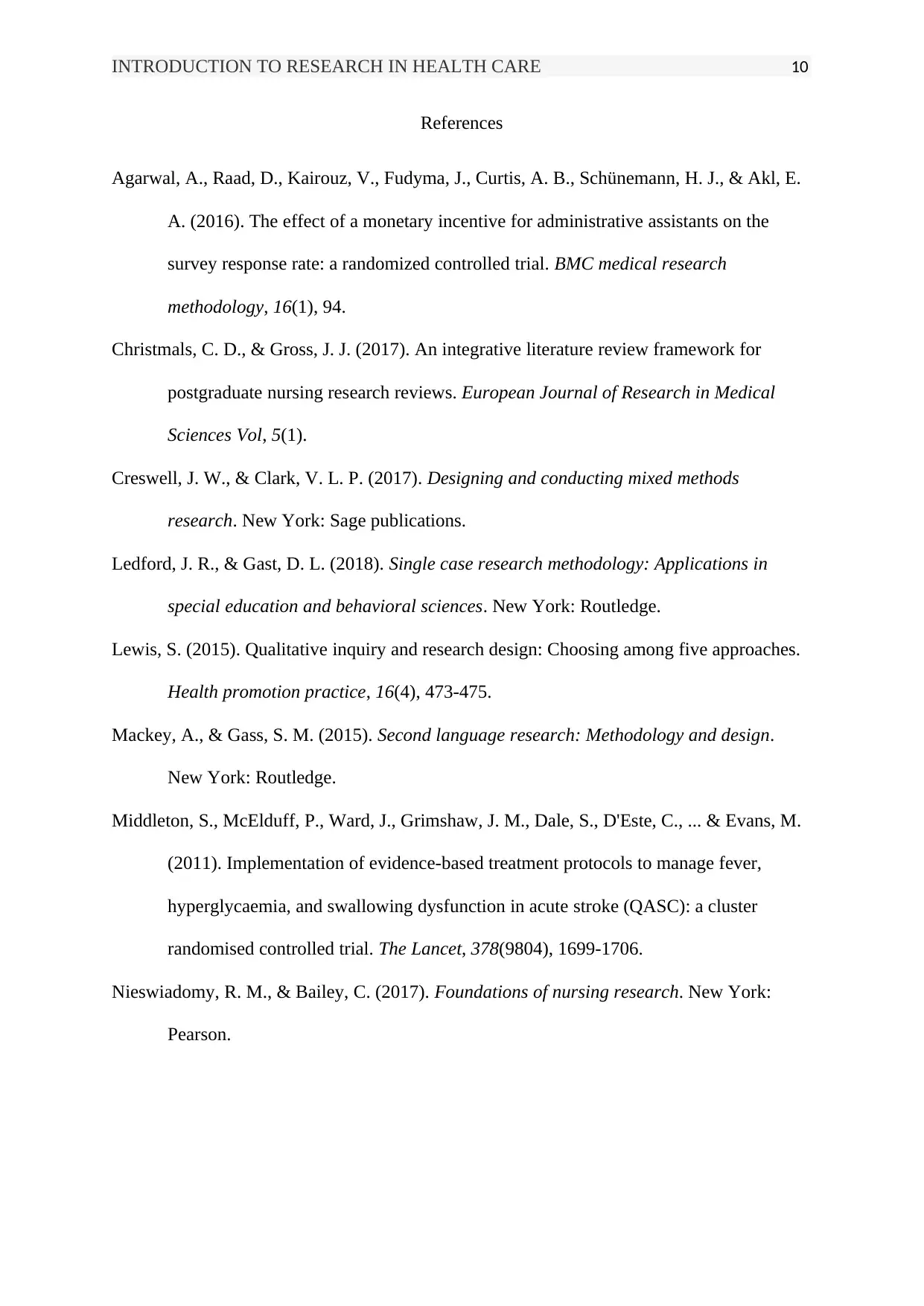
INTRODUCTION TO RESEARCH IN HEALTH CARE 10
References
Agarwal, A., Raad, D., Kairouz, V., Fudyma, J., Curtis, A. B., Schünemann, H. J., & Akl, E.
A. (2016). The effect of a monetary incentive for administrative assistants on the
survey response rate: a randomized controlled trial. BMC medical research
methodology, 16(1), 94.
Christmals, C. D., & Gross, J. J. (2017). An integrative literature review framework for
postgraduate nursing research reviews. European Journal of Research in Medical
Sciences Vol, 5(1).
Creswell, J. W., & Clark, V. L. P. (2017). Designing and conducting mixed methods
research. New York: Sage publications.
Ledford, J. R., & Gast, D. L. (2018). Single case research methodology: Applications in
special education and behavioral sciences. New York: Routledge.
Lewis, S. (2015). Qualitative inquiry and research design: Choosing among five approaches.
Health promotion practice, 16(4), 473-475.
Mackey, A., & Gass, S. M. (2015). Second language research: Methodology and design.
New York: Routledge.
Middleton, S., McElduff, P., Ward, J., Grimshaw, J. M., Dale, S., D'Este, C., ... & Evans, M.
(2011). Implementation of evidence-based treatment protocols to manage fever,
hyperglycaemia, and swallowing dysfunction in acute stroke (QASC): a cluster
randomised controlled trial. The Lancet, 378(9804), 1699-1706.
Nieswiadomy, R. M., & Bailey, C. (2017). Foundations of nursing research. New York:
Pearson.
References
Agarwal, A., Raad, D., Kairouz, V., Fudyma, J., Curtis, A. B., Schünemann, H. J., & Akl, E.
A. (2016). The effect of a monetary incentive for administrative assistants on the
survey response rate: a randomized controlled trial. BMC medical research
methodology, 16(1), 94.
Christmals, C. D., & Gross, J. J. (2017). An integrative literature review framework for
postgraduate nursing research reviews. European Journal of Research in Medical
Sciences Vol, 5(1).
Creswell, J. W., & Clark, V. L. P. (2017). Designing and conducting mixed methods
research. New York: Sage publications.
Ledford, J. R., & Gast, D. L. (2018). Single case research methodology: Applications in
special education and behavioral sciences. New York: Routledge.
Lewis, S. (2015). Qualitative inquiry and research design: Choosing among five approaches.
Health promotion practice, 16(4), 473-475.
Mackey, A., & Gass, S. M. (2015). Second language research: Methodology and design.
New York: Routledge.
Middleton, S., McElduff, P., Ward, J., Grimshaw, J. M., Dale, S., D'Este, C., ... & Evans, M.
(2011). Implementation of evidence-based treatment protocols to manage fever,
hyperglycaemia, and swallowing dysfunction in acute stroke (QASC): a cluster
randomised controlled trial. The Lancet, 378(9804), 1699-1706.
Nieswiadomy, R. M., & Bailey, C. (2017). Foundations of nursing research. New York:
Pearson.
1 out of 10
Related Documents
Your All-in-One AI-Powered Toolkit for Academic Success.
+13062052269
info@desklib.com
Available 24*7 on WhatsApp / Email
![[object Object]](/_next/static/media/star-bottom.7253800d.svg)
Unlock your academic potential
© 2024 | Zucol Services PVT LTD | All rights reserved.





